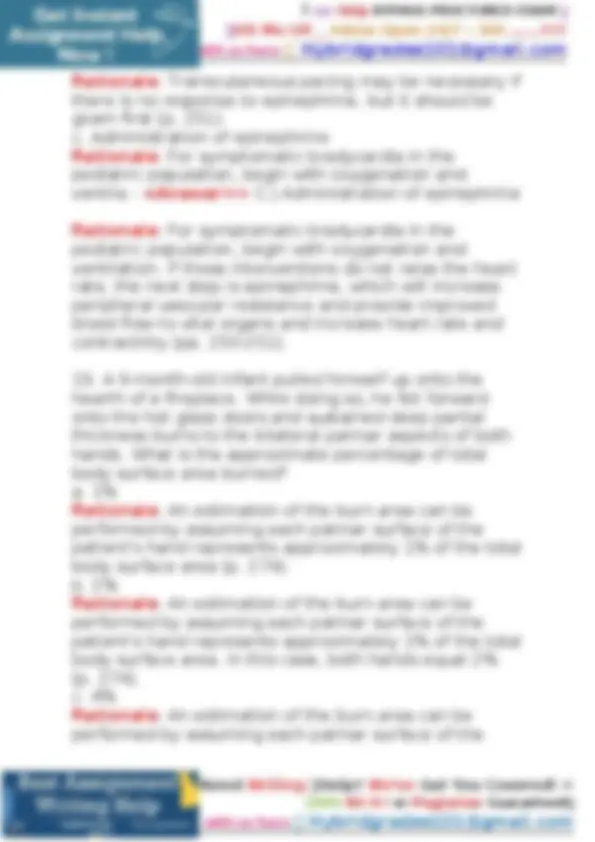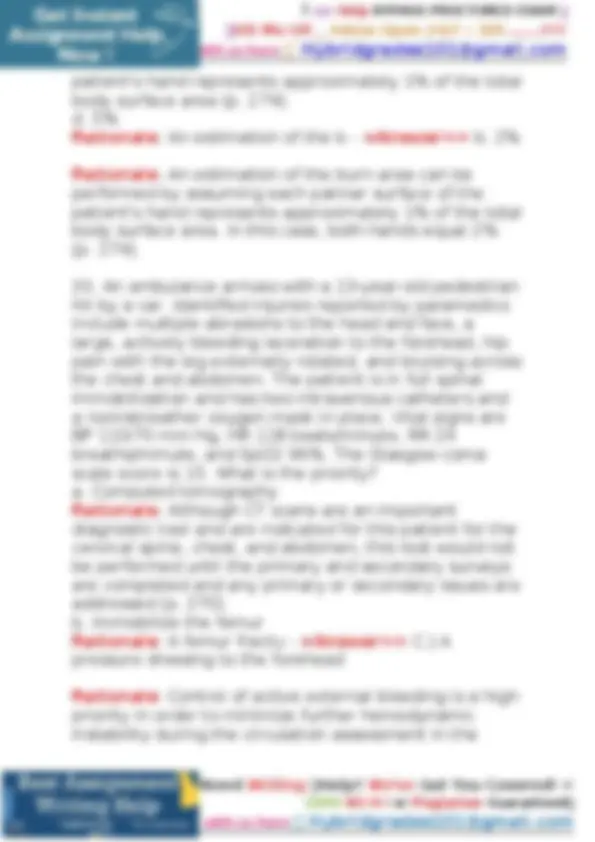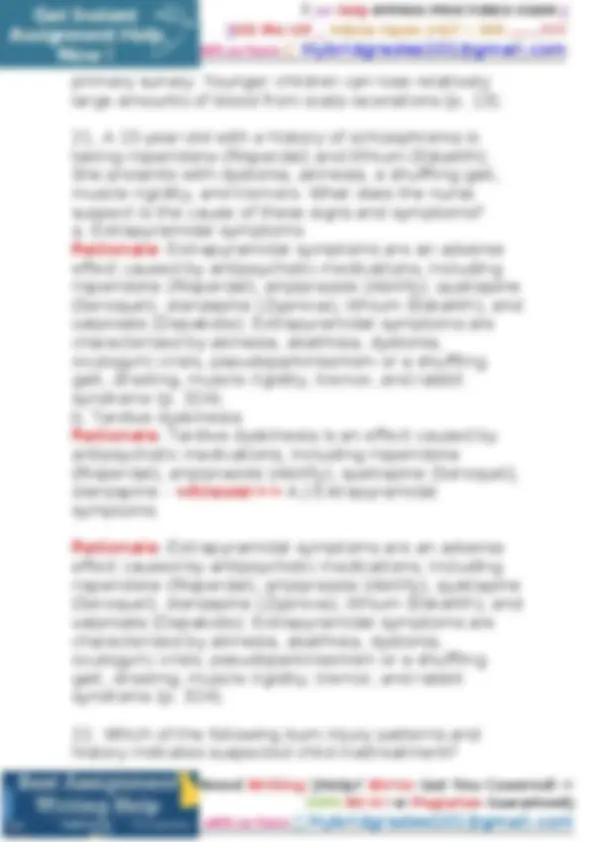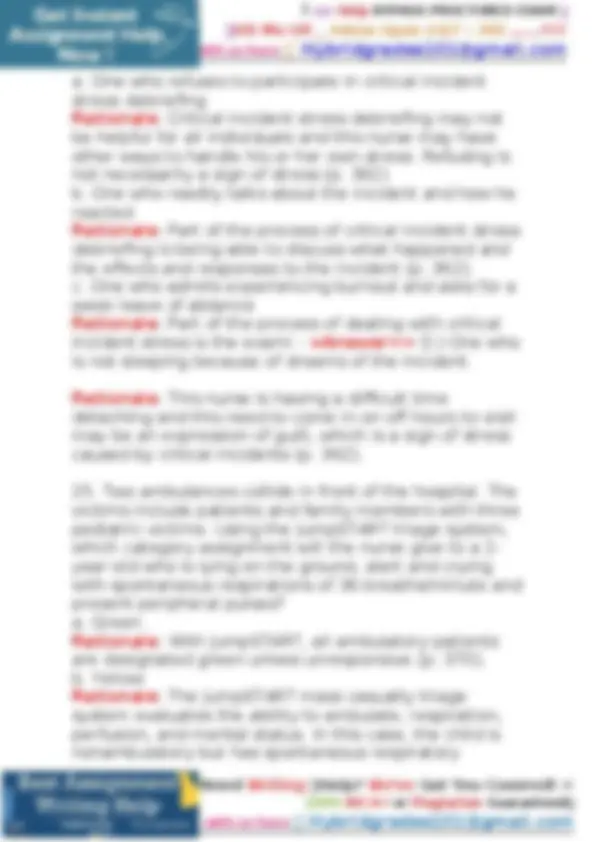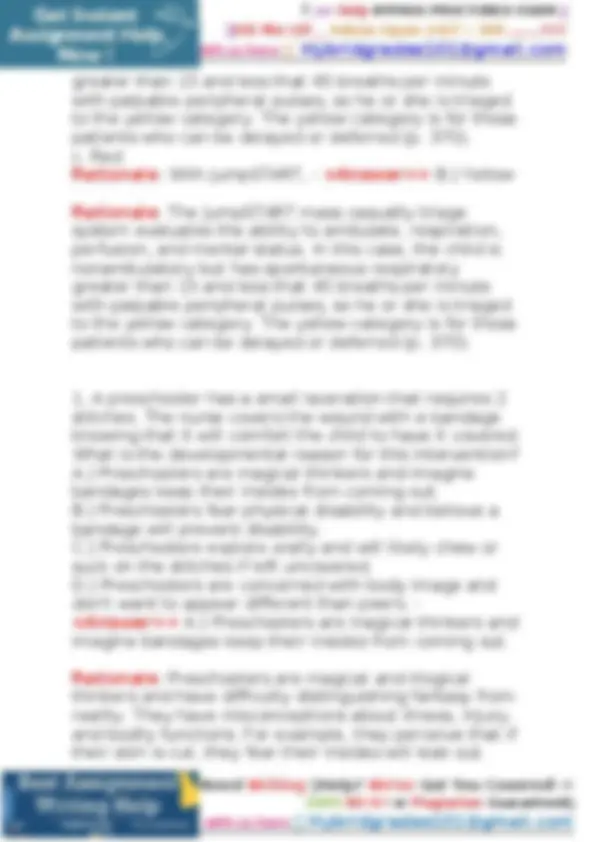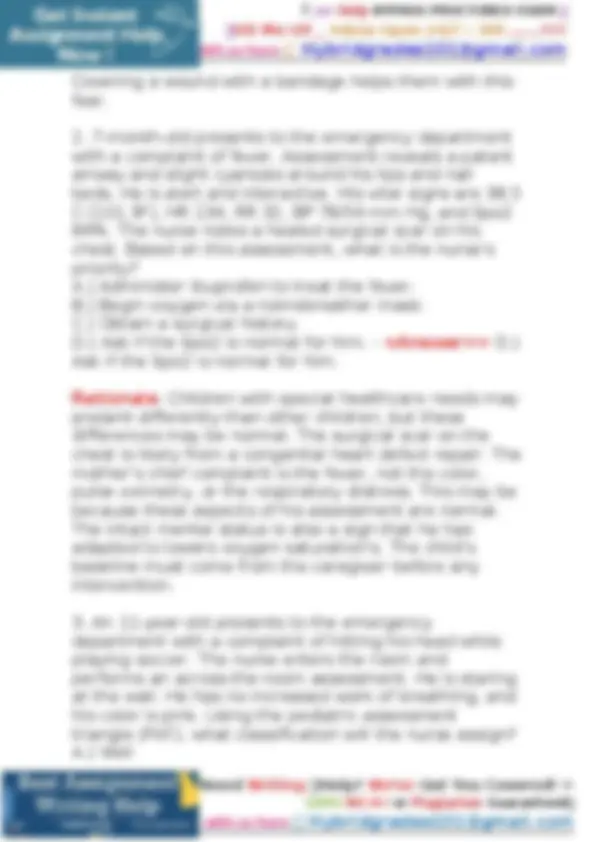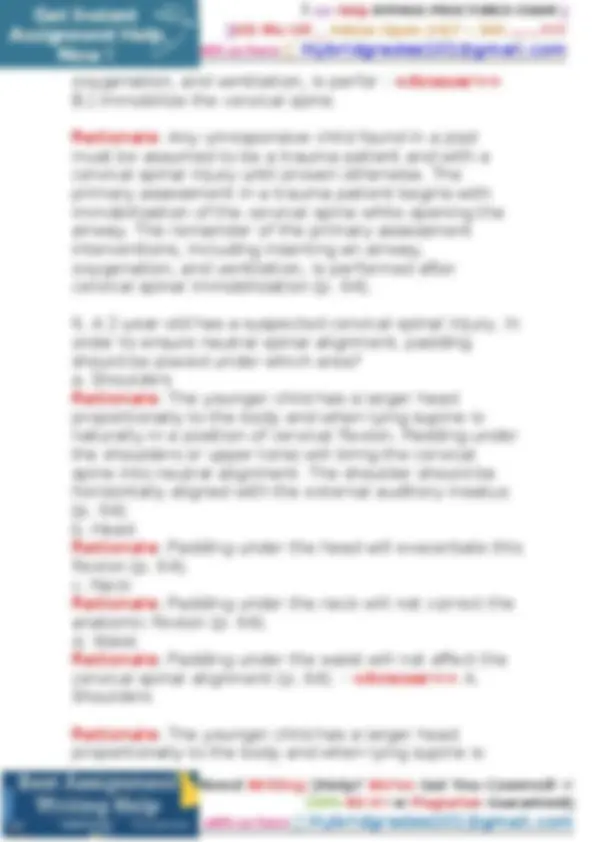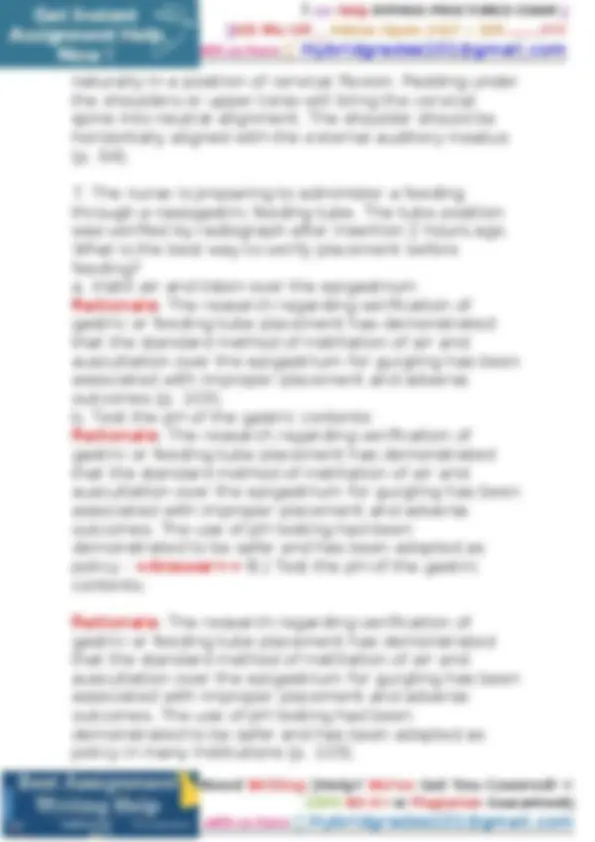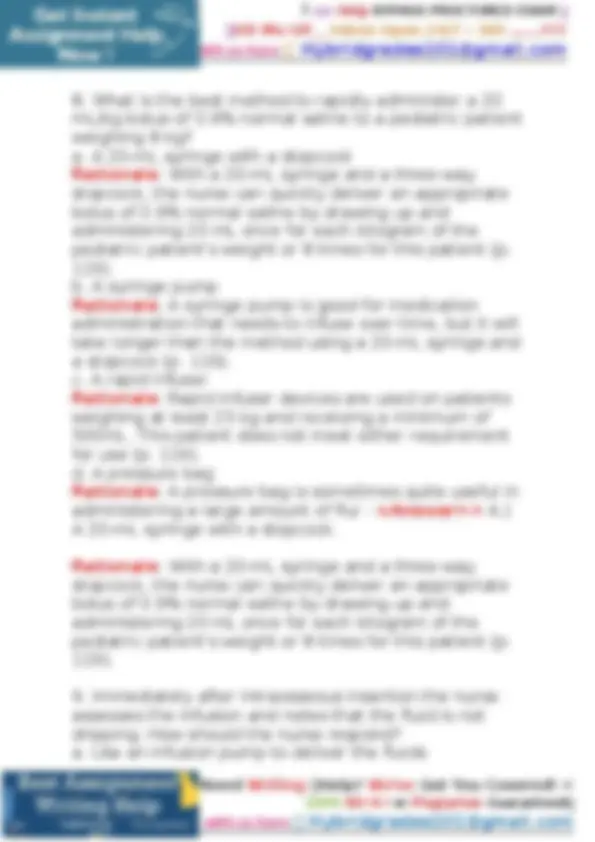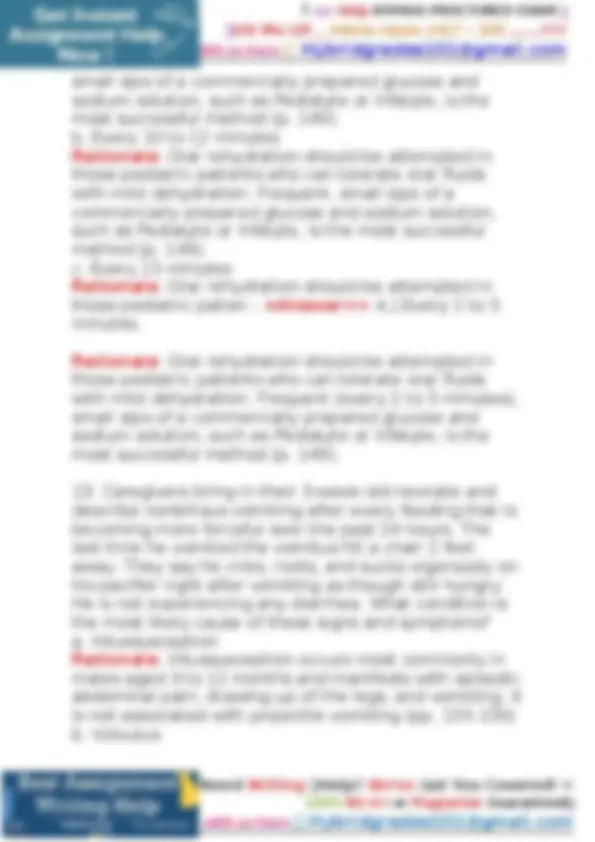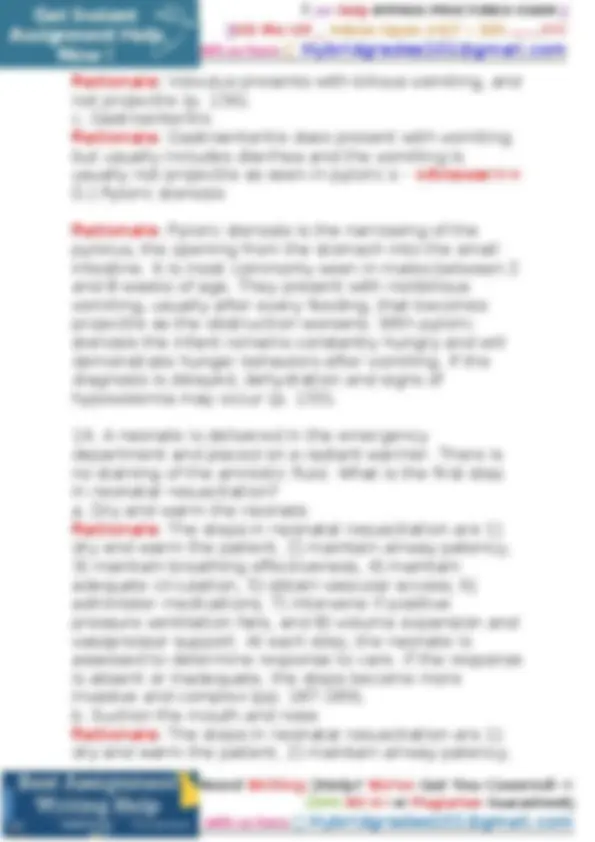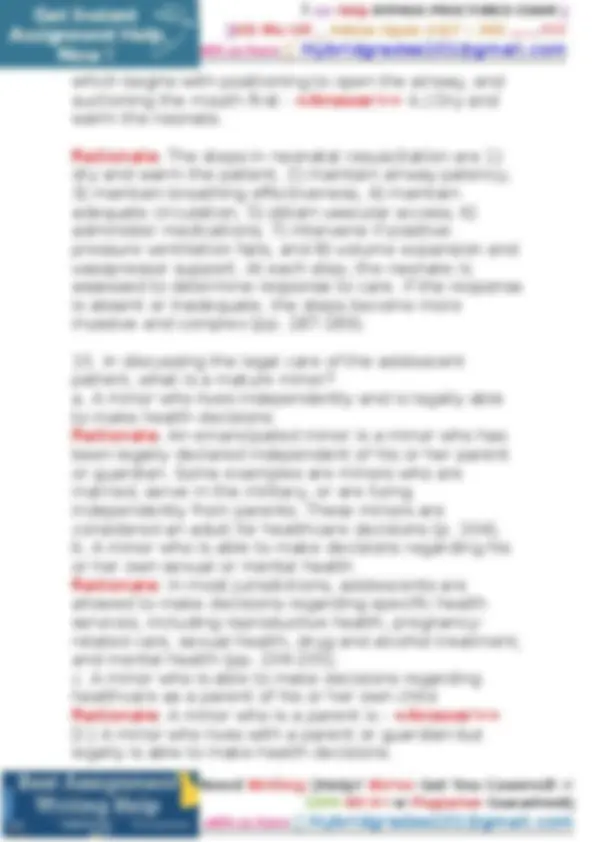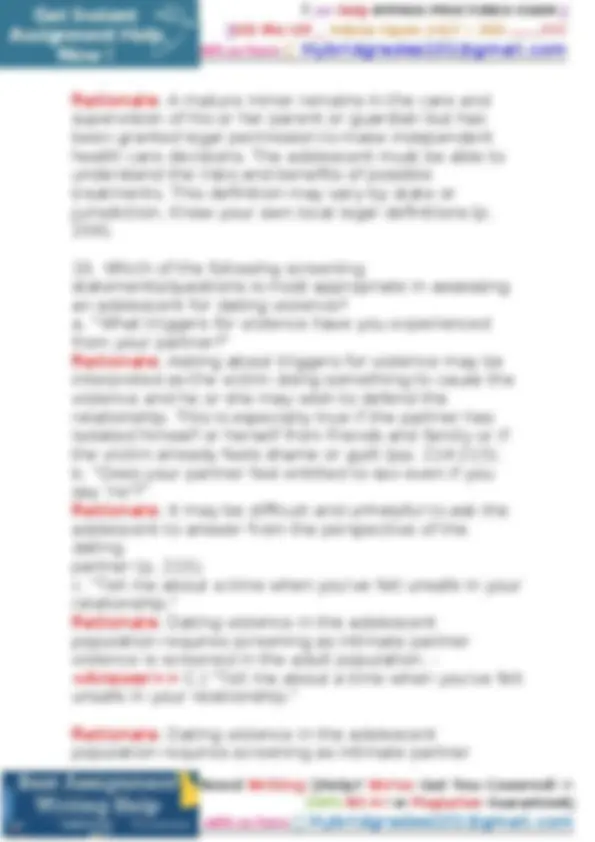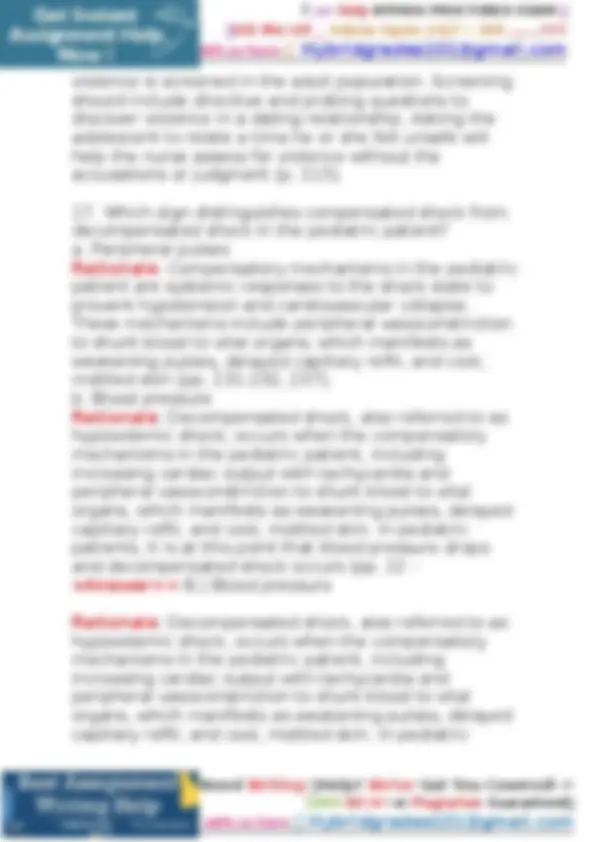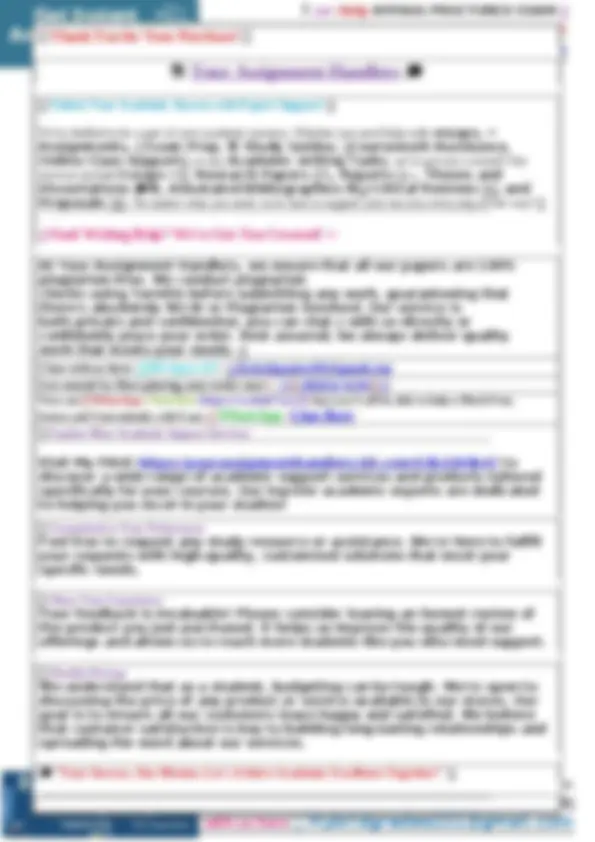Download ENPC Emergency Nursing Pediatric Course Exam Review: Questions and Answers and more Exams Traumatology in PDF only on Docsity!
ENA Emergency Nurses
Association
ENPC Emergency Nursing Pediatric Course
ENPC Certification Written Exam &
Pediatric Trauma Scenarios Assessment
Course Title and Number: ATLS Written Examination & Practical Skills Assessment Exam Title: ATLS Exam Exam Date: Exam 2025- 2026 Instructor: ____ [Insert Instructor’s Name] _______ Student Name: ___ [Insert Student’s Name] _____ Student ID: ____ [Insert Student ID] _____________
Examination
Time: - ____ Hours: ___ Minutes
Instructions:
- Read each question carefully.
- Answer all questions.
- Use the provided answer sheet to mark your responses.
- Ensure all answers are final before submitting the exam.
- Please answer each question below and click Submit when you have completed the Exam.
- This test has a time limit, The test will save and submit automatically when the time expires
- This is Exam which will assess your knowledge on the course Learning Resources.
Good Luck……...!
📱Hit Me UP__ Inbox Open 24/7 – 365 …...!!!! 📱 Chat with us here : 📱 Hybridgrades101@gmail.com
ENPC 4
th
Edition Final ENPC Exam Review
Emergency Nursing Pediatric Course
Questions and Answers | 100% Pass
Guaranteed | Graded A+ |
ENPC Certification Written Exam & Pediatric
Trauma Scenarios Assessment
ENPC Emergency Nursing Pediatric Course
Read All Instructions Carefully and Answer All the Questions Correctly Good Luck: -
- A 5-year-old arrives to the emergency department unconscious with a heart rate of 32 beats/minute, weak, thready pulses, and pale, mottled skin. The team has begun bag-mask ventilation with 100% oxygen and chest compressions with no improvement in the heart rate. An intraosseous line is in place. Which of the following interventions is the priority? a. Administration of atropine Rationale: Atropine is only indicated in pediatric bradycardia if it is the result of vagal nerve stimulation. If the history does not indicate a reason for vagal stimulation, such as vigorous suctioning, the medication of choice is epinephrine (p. 251). b. Transcutaneous pacing Need Writing 📱Help? We've Got You Covered! ✍ 100% NO A I or Plagiarism Guaranteed📱 Click Here To <> Follow Link
https://yourassignmenthandlers.kit.com/93b2309b
!!!.ORDER NOW.!!! << TO GET INSTANT EXPERT HELP >> !!!.ORDER
NOW.!!!
📱Hit Me UP__ Inbox Open 24/7 – 365 …...!!!! 📱 Chat with us here : 📱 Hybridgrades101@gmail.com patient's hand represents approximately 1% of the total body surface area (p. 274). d. 5% Rationale: An estimation of the b - =Answer>> b. 2% Rationale: An estimation of the burn area can be performed by assuming each palmar surface of the patient's hand represents approximately 1% of the total body surface area. In this case, both hands equal 2% (p. 274).
- An ambulance arrives with a 13-year-old pedestrian hit by a car. Identified injuries reported by paramedics include multiple abrasions to the head and face, a large, actively bleeding laceration to the forehead, hip pain with the leg externally rotated, and bruising across the chest and abdomen. The patient is in full spinal immobilization and has two intravenous catheters and a nonrebreather oxygen mask in place. Vital signs are BP 110/70 mm Hg, HR 118 beats/minute, RR 24 breaths/minute, and SpO2 96%. The Glasgow coma scale score is 15. What is the priority? a. Computed tomography Rationale: Although CT scans are an important diagnostic tool and are indicated for this patient for the cervical spine, chest, and abdomen, this test would not be performed until the primary and secondary surveys are completed and any primary or secondary issues are addressed (p. 270). b. Immobilize the femur Rationale: A femur fractu - =Answer>> C.) A pressure dressing to the forehead Rationale: Control of active external bleeding is a high priority in order to minimize further hemodynamic instability during the circulation assessment in the Need Writing 📱Help? We've Got You Covered! ✍ 100% NO A I or Plagiarism Guaranteed📱
📱Hit Me UP__ Inbox Open 24/7 – 365 …...!!!! 📱 Chat with us here : 📱 Hybridgrades101@gmail.com primary survey. Younger children can lose relatively large amounts of blood from scalp lacerations (p. 13).
- A 15-year-old with a history of schizophrenia is taking risperidone (Risperdal) and lithium (Eskalith). She presents with dystonia, akinesia, a shuffling gait, muscle rigidity, and tremors. What does the nurse suspect is the cause of these signs and symptoms? a. Extrapyramidal symptoms Rationale: Extrapyramidal symptoms are an adverse effect caused by antipsychotic medications, including risperidone (Risperdal), aripiprazole (Abilify), quetiapine (Seroquel), olanzapine (Zyprexa), lithium (Eskalith), and valproate (Depakote). Extrapyramidal symptoms are characterized by akinesia, akathisia, dystonia, oculogyric crisis, pseudoparkinsonism or a shuffling gait, drooling, muscle rigidity, tremor, and rabbit syndrome (p. 324). b. Tardive dyskinesia Rationale: Tardive dyskinesia is an effect caused by antipsychotic medications, including risperidone (Risperdal), aripiprazole (Abilify), quetiapine (Seroquel), olanzapine - =Answer>> A.) Extrapyramidal symptoms Rationale: Extrapyramidal symptoms are an adverse effect caused by antipsychotic medications, including risperidone (Risperdal), aripiprazole (Abilify), quetiapine (Seroquel), olanzapine (Zyprexa), lithium (Eskalith), and valproate (Depakote). Extrapyramidal symptoms are characterized by akinesia, akathisia, dystonia, oculogyric crisis, pseudoparkinsonism or a shuffling gait, drooling, muscle rigidity, tremor, and rabbit syndrome (p. 324).
- Which of the following burn injury patterns and history indicates suspected child maltreatment? Need Writing 📱Help? We've Got You Covered! ✍ 100% NO A I or Plagiarism Guaranteed📱
📱Hit Me UP__ Inbox Open 24/7 – 365 …...!!!! 📱 Chat with us here : 📱 Hybridgrades101@gmail.com The infant is responsive only to painful stimuli. The anterior fontanel is bulging. He is mildly tachycardic, but otherwise vital signs are normal. What diagnostic evaluation will the nurse expect for this infant? a. Upper gastrointestinal (GI) series Rationale: While the infant has been vomiting, this is likely from increased intracranial pressure, as indicated by the bulging fontanel, not from any gastrointestinal process. An upper GI series is not indicated at this time(p. 276). b. Skeletal survey Rationale: The infant is exhibiting signs and symptoms of abusive head trauma, formerly known as shaken baby syndrome. A skeletal survey should be done in order to detect any rib fractures, which can be - =Answer>> B.) Skeletal survey Rationale: The infant is exhibiting signs and symptoms of abusive head trauma, formerly known as shaken baby syndrome. A skeletal survey should be done in order to detect any rib fractures, which can be an concurrent injury with abusive head trauma. Other signs and symptoms consistent with abusive head trauma include bruising consistent with grip marks around the chest, fixed and dilated pupils, and retinal hemorrhages. In addition, a skeletal survey may reveal healing fractures from previous abuse. Computed tomography of the head should also be done to evaluate for cerebral edema or intracranial hematoma (p. 351).
- A malfunctioning oxygen tank explodes near a child's bed in the emergency department, resulting in an extensive burn injury to the child. Four nurses participate in the child's immediate care. Which nurse requires intervention after this critical incident? Need Writing 📱Help? We've Got You Covered! ✍ 100% NO A I or Plagiarism Guaranteed📱
📱Hit Me UP__ Inbox Open 24/7 – 365 …...!!!! 📱 Chat with us here : 📱 Hybridgrades101@gmail.com a. One who refuses to participate in critical incident stress debriefing Rationale: Critical incident stress debriefing may not be helpful for all individuals and this nurse may have other ways to handle his or her own stress. Refusing is not necessarily a sign of stress (p. 362) b. One who readily talks about the incident and how he reacted Rationale: Part of the process of critical incident stress debriefing is being able to discuss what happened and the effects and responses to the incident (p. 362). c. One who admits experiencing burnout and asks for a week leave of absence Rationale: Part of the process of dealing with critical incident stress is the exami - =Answer>> D.) One who is not sleeping because of dreams of the incident. Rationale: This nurse is having a difficult time detaching and this need to come in on off hours to visit may be an expression of guilt, which is a sign of stress caused by critical incidents (p. 362).
- Two ambulances collide in front of the hospital. The victims include patients and family members with three pediatric victims. Using the JumpSTART triage system, which category assignment will the nurse give to a 2- year-old who is lying on the ground, alert and crying with spontaneous respirations of 36 breaths/minute and present peripheral pulses? a. Green Rationale: With JumpSTART, all ambulatory patients are designated green unless unresponsive (p. 370). b. Yellow Rationale: The JumpSTART mass casualty triage system evaluates the ability to ambulate, respiration, perfusion, and mental status. In this case, the child is nonambulatory but has spontaneous respiratory Need Writing 📱Help? We've Got You Covered! ✍ 100% NO A I or Plagiarism Guaranteed📱
📱Hit Me UP__ Inbox Open 24/7 – 365 …...!!!! 📱 Chat with us here : 📱 Hybridgrades101@gmail.com Covering a wound with a bandage helps them with this fear.
- 7-month-old presents to the emergency department with a complaint of fever. Assessment reveals a patent airway and slight cyanosis around his lips and nail beds. He is alert and interactive. His vital signs are 38. C (101.3F), HR 134, RR 32, BP 78/54 mm Hg, and Spo 84%. The nurse notes a healed surgical scar on his chest. Based on this assessment, what is the nurse's priority? A.) Administer ibuprofen to treat the fever. B.) Begin oxygen via a nonrebreather mask. C.) Obtain a surgical history. D.) Ask if the Spo2 is normal for him. - =Answer>> D.) Ask if the Spo2 is normal for him. Rationale: Children with special healthcare needs may present differently than other children, but these differences may be normal. The surgical scar on the chest is likely from a congenital heart defect repair. The mother's chief complaint is the fever, not the color, pulse oximetry, or the respiratory distress. This may be because these aspects of his assessment are normal. The intact mental status is also a sign that he has adapted to lowers oxygen saturation's. The child's baseline must come from the caregiver before any intervention.
- An 11-year-old presents to the emergency department with a complaint of hitting his head while playing soccer. The nurse enters the room and performs an across-the-room assessment. He is staring at the wall. He has no increased work of breathing, and his color is pink. Using the pediatric assessment triangle (PAT), what classification will the nurse assign? A.) Well Need Writing 📱Help? We've Got You Covered! ✍ 100% NO A I or Plagiarism Guaranteed📱
📱Hit Me UP__ Inbox Open 24/7 – 365 …...!!!! 📱 Chat with us here : 📱 Hybridgrades101@gmail.com Rationale: In using the PAT, there is not a Well category. A child may appear well and without disruption in any of the three components of the PAT but is still designated sick. All pediatric patients presenting to the emergency department are considered sick simply based on the fact that the caregiver was concerned enough to bring the child to the emergency department (p. 54). B.) Sick Rationale: If there is no disruption in any of the three components of the PAT, a pediatric patient is considered sick. This child has an abnormality in one of the thre - =Answer>> C.) Sicker Rationale: This child has a disruption in one of the three components of the PAT. He is staring at the wall, which is a disruption in the general appearance component. It may be that he is anxious and fearful about the experience, but it could be a result of the head injury. More assessment is required (p. 54).
- The pediatric prioritization process components include the focused assessment, focused history, acuity rating decision and: A.) the pediatric assessment triangle (PAT). Rationale: The four components of the pediatric prioritization process include the pediatric assessment triangle (PAT), the focused assessment (objective data), the focused history (subjective data), and the assignment of the triage acuity rating. These components ensure enough information is rapidly gathered and used to provide appropriate care and timely interventions for pediatric patients (p. 52). B.) developmental characteristics. Rationale: Developmental characteristics are incorporated into each component of the pediatric prioritization Need Writing 📱Help? We've Got You Covered! ✍ 100% NO A I or Plagiarism Guaranteed📱
📱Hit Me UP__ Inbox Open 24/7 – 365 …...!!!! 📱 Chat with us here : 📱 Hybridgrades101@gmail.com oxygenation, and ventilation, is perfor - =Answer>> B.) Immobilize the cervical spine. Rationale: Any unresponsive child found in a pool must be assumed to be a trauma patient and with a cervical spinal injury until proven otherwise. The primary assessment in a trauma patient begins with immobilization of the cervical spine while opening the airway. The remainder of the primary assessment interventions, including inserting an airway, oxygenation, and ventilation, is performed after cervical spinal immobilization (p. 64).
- A 2-year-old has a suspected cervical spinal injury. In order to ensure neutral spinal alignment, padding should be placed under which area? a. Shoulders Rationale: The younger child has a larger head proportionally to the body and when lying supine is naturally in a position of cervical flexion. Padding under the shoulders or upper torso will bring the cervical spine into neutral alignment. The shoulder should be horizontally aligned with the external auditory meatus (p. 64). b. Head Rationale: Padding under the head will exacerbate this flexion (p. 64). c. Neck Rationale: Padding under the neck will not correct the anatomic flexion (p. 64). d. Waist Rationale: Padding under the waist will not affect the cervical spinal alignment (p. 64). - =Answer>> A. Shoulders Rationale: The younger child has a larger head proportionally to the body and when lying supine is Need Writing 📱Help? We've Got You Covered! ✍ 100% NO A I or Plagiarism Guaranteed📱
📱Hit Me UP__ Inbox Open 24/7 – 365 …...!!!! 📱 Chat with us here : 📱 Hybridgrades101@gmail.com naturally in a position of cervical flexion. Padding under the shoulders or upper torso will bring the cervical spine into neutral alignment. The shoulder should be horizontally aligned with the external auditory meatus (p. 64).
- The nurse is preparing to administer a feeding through a nasogastric feeding tube. The tube position was verified by radiograph after insertion 2 hours ago. What is the best way to verify placement before feeding? a. Instill air and listen over the epigastrium Rationale: The research regarding verification of gastric or feeding tube placement has demonstrated that the standard method of instillation of air and auscultation over the epigastrium for gurgling has been associated with improper placement and adverse outcomes (p. 103). b. Test the pH of the gastric contents Rationale: The research regarding verification of gastric or feeding tube placement has demonstrated that the standard method of instillation of air and auscultation over the epigastrium for gurgling has been associated with improper placement and adverse outcomes. The use of pH testing had been demonstrated to be safer and has been adopted as policy - =Answer>> B.) Test the pH of the gastric contents. Rationale: The research regarding verification of gastric or feeding tube placement has demonstrated that the standard method of instillation of air and auscultation over the epigastrium for gurgling has been associated with improper placement and adverse outcomes. The use of pH testing had been demonstrated to be safer and has been adopted as policy in many institutions (p. 103). Need Writing 📱Help? We've Got You Covered! ✍ 100% NO A I or Plagiarism Guaranteed📱
📱Hit Me UP__ Inbox Open 24/7 – 365 …...!!!! 📱 Chat with us here : 📱 Hybridgrades101@gmail.com Rationale: Fluids infusing through an intraosseous device do not necessarily run by gravity. The use of an infusion pump is usually required (p. 127). b. Remove the device and insert in another site Rationale: Fluids infusing through an intraosseous device do not necessarily run by gravity. This does not mean it is nonfunctional and removal is not indicated (p. 127). c. Advance the device and reassess the flow Rationale: Advancing the device if it is currently correctly placed may penetrate the far wall of the bone and produce infiltration (p. 127). d. Attempt to aspirate bone marrow Rationale: Aspiration of bone marrow confirms correct placement of an intraosseous device, but lack of return is not a sign of incorrect placemen - =Answer>> A.) Use an infusion pump to deliver the fluids Rationale: Fluids infusing through an intraosseous device do not necessarily run by gravity. The use of an infusion pump is usually required (p. 127).
- A 13-month-old presents to the emergency department with a 2-day history of a low-grade fever, increased work of breathing, and tonight developed a barking cough and inspiratory stridor. What condition does the nurse suspect? a. Epiglottitis Rationale: Epiglottitis has a sudden onset of high fever, sore throat, difficulty swallowing, and muffled voice and quickly progresses to drooling, tripod positioning, and stridor (p. 137). b. Foreign body aspiration Rationale: This patient is the right age for a foreign body aspiration as it is more common in infants and toddlers who explore the world orally, but the gradual Need Writing 📱Help? We've Got You Covered! ✍ 100% NO A I or Plagiarism Guaranteed📱
📱Hit Me UP__ Inbox Open 24/7 – 365 …...!!!! 📱 Chat with us here : 📱 Hybridgrades101@gmail.com onset, low-grade fever, and barking cough indicates an infectious process, specifically croup (p. 137). c. Tracheomalacia Rationale: Tracheomalacia is a chronic condition affecting the upper airway that may be an indication for a tracheostomy, but it is not acute, nor associated with infectious processes - =Answer>> D.) Croup Rationale: Croup is most commonly seen in children between the ages of 6 and 36 months and has a gradual onset of cold symptoms including a low-grade fever, tachypnea, tachycardia, retractions, and inspiratory stridor. The classic sign is a barking cough that worsens at night (p. 137).
- In providing education to a family regarding obtaining baseline peak airway flow for a child with asthma, the nurse will recommend what time of day? a. At bedtime. b. Before exercise c. In the morning. d. After meal. - =Answer>> C.) In the morning. Rationale: The recommended time to obtain baseline peak flow readings is first thing in the morning before any administration of bronchodilator therapy (pp. 138, 140).
- The nurse is planning to begin oral rehydration therapy for a 9-month-old with mild dehydration. She provides the caregivers with a glucose and sodium solution and instructs them to administer small amounts: a. Every 2 to 5 minutes Rationale: Oral rehydration should be attempted in those pediatric patients who can tolerate oral fluids with mild dehydration. Frequent (every 2 to 5 minutes), Need Writing 📱Help? We've Got You Covered! ✍ 100% NO A I or Plagiarism Guaranteed📱
📱Hit Me UP__ Inbox Open 24/7 – 365 …...!!!! 📱 Chat with us here : 📱 Hybridgrades101@gmail.com Rationale: Volvulus presents with bilious vomiting, and not projectile (p. 156). c. Gastroenteritis Rationale: Gastroenteritis does present with vomiting but usually includes diarrhea and the vomiting is usually not projectile as seen in pyloric s - =Answer>> D.) Pyloric stenosis Rationale: Pyloric stenosis is the narrowing of the pylorus, the opening from the stomach into the small intestine. It is most commonly seen in males between 2 and 8 weeks of age. They present with nonbilious vomiting, usually after every feeding, that becomes projectile as the obstruction worsens. With pyloric stenosis the infant remains constantly hungry and will demonstrate hunger behaviors after vomiting. If the diagnosis is delayed, dehydration and signs of hypovolemia may occur (p. 155).
- A neonate is delivered in the emergency department and placed on a radiant warmer. There is no staining of the amniotic fluid. What is the first step in neonatal resuscitation? a. Dry and warm the neonate Rationale: The steps in neonatal resuscitation are 1) dry and warm the patient, 2) maintain airway patency,
- maintain breathing effectiveness, 4) maintain adequate circulation, 5) obtain vascular access, 6) administer medications, 7) intervene if positive pressure ventilation fails, and 8) volume expansion and vasopressor support. At each step, the neonate is assessed to determine response to care. If the response is absent or inadequate, the steps become more invasive and complex (pp. 187-189). b. Suction the mouth and nose Rationale: The steps in neonatal resuscitation are 1) dry and warm the patient, 2) maintain airway patency, Need Writing 📱Help? We've Got You Covered! ✍ 100% NO A I or Plagiarism Guaranteed📱
📱Hit Me UP__ Inbox Open 24/7 – 365 …...!!!! 📱 Chat with us here : 📱 Hybridgrades101@gmail.com which begins with positioning to open the airway, and suctioning the mouth first - =Answer>> A.) Dry and warm the neonate. Rationale: The steps in neonatal resuscitation are 1) dry and warm the patient, 2) maintain airway patency,
- maintain breathing effectiveness, 4) maintain adequate circulation, 5) obtain vascular access, 6) administer medications, 7) intervene if positive pressure ventilation fails, and 8) volume expansion and vasopressor support. At each step, the neonate is assessed to determine response to care. If the response is absent or inadequate, the steps become more invasive and complex (pp. 187-189).
- In discussing the legal care of the adolescent patient, what is a mature minor? a. A minor who lives independently and is legally able to make health decisions Rationale: An emancipated minor is a minor who has been legally declared independent of his or her parent or guardian. Some examples are minors who are married, serve in the military, or are living independently from parents. These minors are considered an adult for healthcare decisions (p. 204). b. A minor who is able to make decisions regarding his or her own sexual or mental health Rationale: In most jurisdictions, adolescents are allowed to make decisions regarding specific health services, including reproductive health, pregnancy- related care, sexual health, drug and alcohol treatment, and mental health (pp. 204-205). c. A minor who is able to make decisions regarding healthcare as a parent of his or her own child Rationale: A minor who is a parent is - =Answer>> D.) A minor who lives with a parent or guardian but legally is able to make health decisions. Need Writing 📱Help? We've Got You Covered! ✍ 100% NO A I or Plagiarism Guaranteed📱

